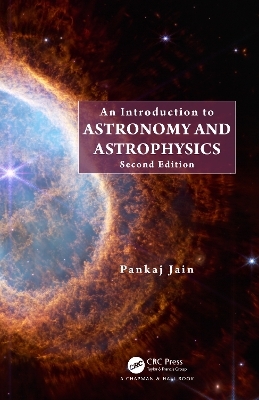
An Introduction to Astronomy and Astrophysics
Chapman & Hall/CRC (Verlag)
978-0-367-25758-3 (ISBN)
Astronomy is the field of science devoted to the study of astronomical objects, such as stars, galaxies, and nebulae. Astronomers have gathered a wealth of knowledge about the universe through hundreds of years of painstaking observations. These observations are interpreted by the use of physical and chemical laws familiar to mankind. These interpretations supply information about the nature of these astronomical objects, allowing for the deduction of their surface and interior conditions. The science associated with these interpretations is called astrophysics.
An Introduction to Astronomy and Astrophysics offers a comprehensive introduction to astronomy and astrophysics, complete with illustrative examples and illuminating homework problems. Requiring a familiarity with basic physics and mathematics, this undergraduate-level textbook:
Addresses key physics concepts relevant to stellar observations, including radiation, electromagnetic spectrum, photometry, continuous and discrete spectrum, and spectral lines.
Describes instruments used for astronomical observations as well as how the radiation received is characterized and interpreted to determine the properties of stars.
Examines the structure of stars, the basic equations that explain stars in equilibrium, and the fusion reactions occurring in stellar cores.
Discusses the evolution of stars, the solar system, the dynamics of galaxies, and the fundamentals of modern cosmology.
Explores the universe at high redshifts, where it is dominated by objects such as active galaxies.
An Introduction to Astronomy and Astrophysics teaches students how to interpret the night sky, providing them with a critical understanding of the stars and sun, solar system, extrasolar planets, stars, and galaxies.
The book is thoroughly revised to make it an essential textbook for students. The Second edition introduces the following changes:
New solutions are provided at the end of all the chapters.
The number of problems has increased.
Major chapters have been considerably revised and new developments in this field have been introduced.
Prof. Pankaj Jain is the head of the Department of Space, Planetary & Astronomical Sciences & Engineering at the Indian Institute of Technology, Kanpur, India. He earlier held the position of Professor of Physics at the same institution. He obtained his doctoral degree in physics from Syracuse University. He has extensive research experience in high-energy particle physics, cosmology and astrophysics. He also has considerable experience in teaching courses in physics, astrophysics and astronomy.
1. Introduction. 1.1. Scales and Dimensions. 1.2. Night Sky. 1.3. Constellations. 1.4. Earth, Sun, and the Solar System. 1.5. Sidereal Time. 1.6. Astronomical Catalogs and Software. 2. Observations. 2.1. Electromagnetic Waves. 2.2. Electromagnetic Spectrum. 2.3. Telescopes. 2.4. Observations at Visible Frequencies. 2.5. Mounting of Telescope. 2.6. Interferometry. 2.7. Observations at Other Wavelengths. 3. Astrometry. 3.1. Coordinate Systems. 3.2. Space Velocity and Proper Motion of Stars. 3.3. Parallax. 3.4. Aberration. 3.5. Coordinate Transformations. 4. Photometry. 4.1. Flux Density and Intensity. 4.2. Blackbody Radiation. 4.3. Energy Density in an Isotropic Radiation Field. 4.4. Magnitude Scale. 4.5. Stellar Temperatures. 4.6. Appendix: Solid Angle. 5. Gravitation and Kepler's Laws. 5.1. Two-Body Problem. 5.2. Application to Solar System. 5.3. Virial Theorem. 5.4. Tidal Forces and Roche Limit. 6. Stars, Stellar Spectra, and Classification. 6.1. Stellar Spectra. 6.2. Harvard Classification of Stellar Spectra. 6.3. Saha Equation. 6.4. Derivation of the Saha Equation. 6.5. Hertzsprung-Russell (HR) Diagram. 6.6. Star Clusters and Associations. 6.7. Distance and Age Determination of Clusters Using Color-Magnitude Diagram. 7. Radiation from Astronomical Sources. 7.1. Continuous Spectra. 7.2. Absorption and Emission Line Spectrum. 7.3. Molecular Band Spectra. 7.4. Extinction. 8. Stellar Structure. 8.1. Pressure Gradient. 8.2. Mass Distribution. 8.3. Energy Production. 8.4. Temperature Gradient. 8.5. Boundary Conditions. 8.6. Rosseland Mean Opacity. 8.7. Equation of State. 8.8. Energy Production in Stars. 8.9. Polytropic Model of a Star. 8.10. Appendix: Maxwell-Boltzmann Distribution. 9. Stellar Nuclear Reactions. 9.1. Fundamental Interactions. 9.2. Fundamental Particles. 9.3. A Brief Introduction to Neutrinos. 9.4. PP Chain. 9.5. Nuclear Reaction Rate. 9.6. Energy Released in Nuclear Reactions. 9.7. Standard Solar Model. 10. Star Formation and Stellar Evolution. 10.1. Early Stage of Star Formation. 10.2. The Main Sequence Phase. 10.3. Degenerate Free Electron Gas. 10.4. Evolution beyond the Main Sequence. 10.5. Population I, II and III Stars. 10.6. White Dwarfs. 10.7. Neutron Star. 10.8. Black Holes. 10.9. Supernova. 11. The Sun. 11.1. Solar Atmosphere. 11.2. Dynamo Mechanism for Magnetic Field Enhancement. 11.3. Sunspots and the Solar Cycle. 11.4. Some Transient Phenomena. 12. The Solar System. 12.1. Orbital Properties of Planets. 12.2. Retrograde Motion of Planets. 12.3. Albedo and Temperature of Planets. 12.4. Terrestrial Planets: Interior Structure. 12.5. Jovian Planets. 12.6. The Moon. 12.7. Why Did Pluto Lose Its Planetship? 12.8. Formation of the Solar System. 13. Binary Stars. 13.1. Kinematics of a Binary Star System. 13.2. Classification of Binary Stars. 13.3. Mass Determination. 13.4. Mass Transfer in Binary Systems. 14. The Milky Way. 14.1. The Distance Ladder. 14.2. Distribution of Matter in the Milky Way. 14.3. Differential Rotation of the Milky Way. 14.4. Mapping the Galactic Disk with Radio Waves. 14.5. Formation of the Spiral Arms. 15. Galaxies. 15.1. Elliptical Galaxies. 15.2. Spiral Galaxies. 15.3. Evidence for Dark Matter. 15.4. Galaxy Clusters and Superclusters. 16. Cosmology. 16.1. Euclidean Space. 16.2. Curved Space. 16.3. Minkowski Space-Time. 16.4. Big Bang Cosmology. 16.5. The Early Universe. 17. Active Galaxies. 17.1. Active Galactic Nuclei: Some Basic Properties. 17.2. Classification of Active Galaxies. 17.3. Unified Model of AGNs.
| Erscheinungsdatum | 19.04.2024 |
|---|---|
| Zusatzinfo | 3 Tables, black and white; 191 Line drawings, black and white; 191 Illustrations, black and white |
| Sprache | englisch |
| Maße | 156 x 234 mm |
| Gewicht | 866 g |
| Themenwelt | Naturwissenschaften ► Biologie |
| Naturwissenschaften ► Physik / Astronomie ► Astronomie / Astrophysik | |
| ISBN-10 | 0-367-25758-0 / 0367257580 |
| ISBN-13 | 978-0-367-25758-3 / 9780367257583 |
| Zustand | Neuware |
| Haben Sie eine Frage zum Produkt? |
aus dem Bereich


